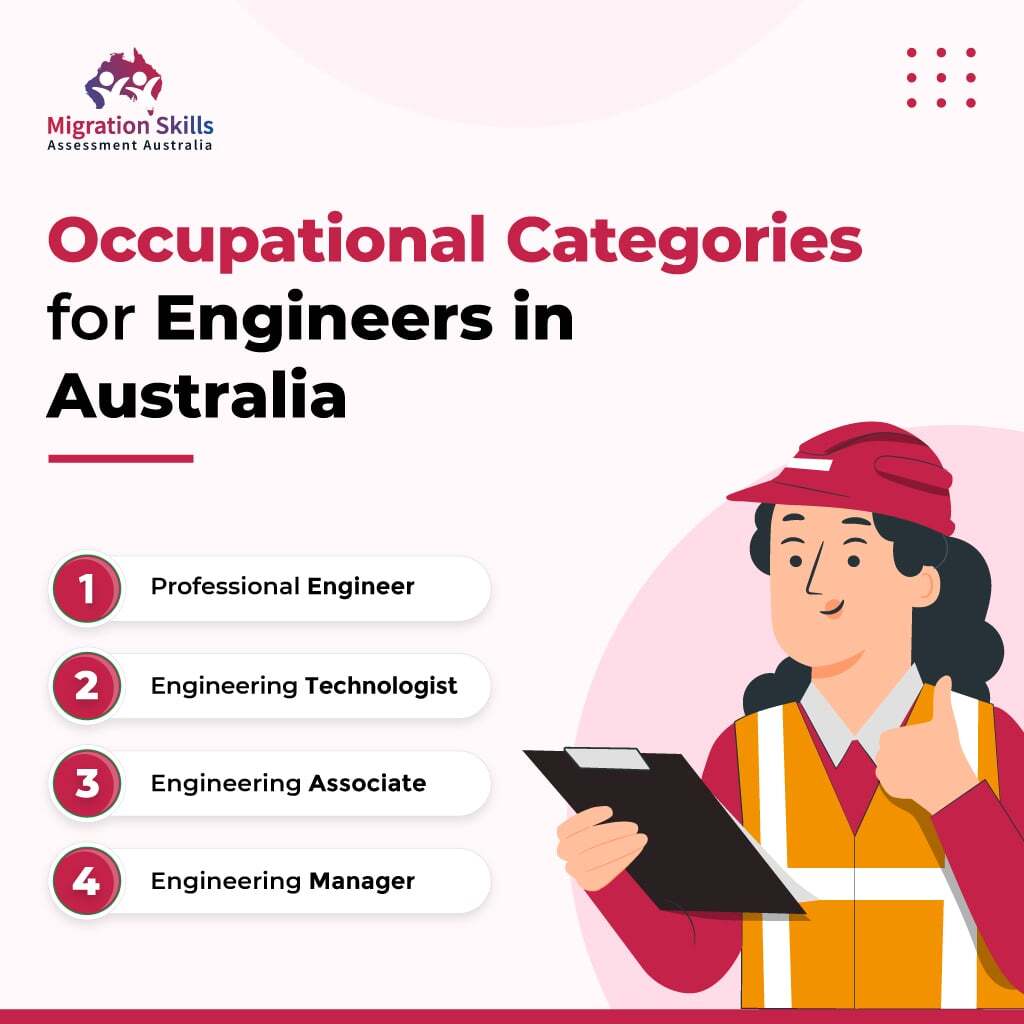Concept of Occupational Categories for Engineers in Australia

Concept of Occupational Categories for Engineers in Australia
Engineering is a field that constantly evolves, driving technological advancements and innovation across various industries. Australia, known for its diverse landscapes and thriving economy, presents an exciting opportunity for engineers seeking to migrate to Australia.
However, the journey to becoming a recognized engineer in Australia involves understanding the occupational categories recognized by Engineers Australia (EA), the main authority governing skilled migration for engineers. In this comprehensive guide, we will delve into the four distinct occupational categories recognized by EA: Professional Engineer, Engineering Technologist, Engineering Associate, and Engineering Manager.
Occupational Categories for Engineers in Australia
We will explore the qualifications, responsibilities, and unique contributions of each category, providing aspiring engineers with a roadmap for success:

1. Professional Engineer
This is like reaching the top level in a game. A Professional Engineer is someone who has a lot of experience and knows how to lead important projects. They’re like the heroes who use their knowledge to make the world a better place.
Qualifications
The first rung on the ladder of engineering recognition in Australia is the Professional Engineer category. To qualify, individuals must possess a 4-year Australian bachelor’s degree in engineering from a recognized institution. This degree should be obtained following 12 years of schooling or its international equivalent. The professional engineer’s journey is marked by academic excellence, dedication, and a thirst for knowledge.
Responsibilities
Professional Engineers hold a pivotal role in shaping the future. Their responsibilities extend beyond technical prowess to encompass a holistic understanding of engineering projects. They are the architects of design and innovation, whether crafting sustainable buildings or revolutionizing medical devices. The role of a Professional Engineer is multifaceted:
- Design and Innovation: Professional Engineers are the driving force behind innovative solutions to complex problems. They utilize their technical knowledge, creativity, and critical thinking skills to develop new technologies, systems, and processes that revolutionize industries.
- Project Management: Leadership is a cornerstone of the Professional Engineer’s role. They oversee projects from planning to execution, ensuring adherence to safety standards, budget constraints, and desired outcomes. Collaboration with diverse teams and resource management are integral aspects of their role.
- Safety and Risk Assessment: Public safety is paramount. Professional Engineers analyze structural integrity, evaluate environmental impact, and implement measures to prevent accidents and disasters. They assess potential risks associated with projects and institute mitigation strategies.
- Regulatory Compliance: Professional Engineers navigate a complex web of regulations and codes. They ensure that their designs and projects comply with industry standards and legal requirements, obtaining necessary permits and approvals.
- Ethical Considerations: Upholding a code of ethics is central to the Professional Engineer’s role. They balance competing interests, prioritize sustainable and responsible practices, and consider the social and environmental impact of their work.
- Continuous Learning: Engineering is a dynamic field, constantly evolving with new technologies. Professional Engineers engage in continuous learning through conferences, certifications, and professional development activities to stay at the forefront of their discipline.
Contribution
The impact of Professional Engineers is far-reaching. From groundbreaking innovations to large-scale infrastructure projects, their contributions shape society’s progress. Their expertise transcends technical aspects; they consider the needs of clients, stakeholders, and the community, optimizing social, ecological, and financial dimensions throughout the lifecycle of engineering projects.
By achieving recognition as Chartered Professional Engineers, they unlock opportunities for greater career advancement and significant contributions to society.
Read More: How to write a complete RPL Report for ACS skills assessment? ✈️✈️
2. Engineering Technologist
Imagine being really good at a special skill that helps solve problems. That’s what an Engineering Technologist does. They’re like problem-solving experts who use their knowledge to make things work.
Qualifications
Engineering evolves beyond theory, and the Engineering Technologist category recognizes those who bridge the gap between theory and practice. Qualifications for this category include a 3-year Australian bachelor of technology degree in engineering, obtained after 12 years of schooling or its equivalent. Engineering Technologists are individuals who possess both theoretical understanding and practical application skills.
Responsibilities
Engineering Technologists are specialists within their chosen domain of engineering technology. Their responsibilities focus on the practical application of theoretical knowledge:
- Application of Knowledge: Engineering Technologists systematically apply their theoretical understanding to real-world scenarios. They ensure the seamless integration of technology within various contexts, adapting established engineering practices to solve practical problems.
- Design and Adaptation: Within their technology domain, Engineering Technologists apply design and adaptation principles. They develop and modify engineering practices, ensuring they align with industry-specific requirements and emerging advancements.
- Technical Environments: Engineering Technologists thrive within technical environments. They take on multifunctional roles, contributing their expertise to feasibility investigations, scoping, quality assurance, costing, and document control.
- Technological Advancements: Staying current with technological developments is critical. Engineering Technologists actively engage with emerging trends and advancements within their domain, incorporating them into their practice to drive innovation.
Contribution
The impact of Engineering Technologists lies in their ability to bridge theory and practice. Their specialized knowledge enables them to translate abstract concepts into tangible solutions. By adapting engineering practices to the ever-evolving technological landscape, they play a pivotal role in driving innovation and enhancing efficiency across various industries.
Read more: Engineering Jobs in Australia: A comprehensive list for Skills Assessment 📑📑
3. Engineering Associate
Starting out on your engineering journey is a bit like being an apprentice. Engineering Associates help with projects and learn from experienced engineers. They’re like the helpers who contribute to the team.
Qualifications
The Engineering Associate category recognizes individuals who anchor practical expertise within specific system elements. Qualifications include a two-year Australian Diploma or Associate Degree in engineering, following 12 years of schooling or its equivalent. Engineering Associates contribute practical insights to engineering enterprises, grounding projects in real-world feasibility.
Responsibilities
Engineering Associates assume diverse roles within engineering enterprises, focusing on specific system components:
- System Focus: Engineering Associates concentrate on specific elements within systems, ensuring a comprehensive understanding of their functionality and integration within the broader context.
- Feasibility and Control: Their responsibilities span feasibility investigations, scoping, costing, budget management, quality assurance, and document control. Engineering Associates play a vital role in ensuring projects adhere to practical and financial constraints.
- Application of Practices: With a solid grounding in established engineering practices, Engineering Associates apply their expertise to execute tasks such as research, design, assembly, construction, operation, installation, manufacture, and distribution.
Contribution
Engineering Associates contribute practical insights to the execution of engineering projects. Their focus on specific components ensures projects are grounded in reality, adhering to feasibility and cost considerations. By applying established practices, they facilitate the smooth implementation of projects, contributing to the overall success of engineering enterprises.
Visit: Engineers Australia Assessment Validity 📑📑
4. Engineering Manager
Imagine being the captain of a ship, making sure everything runs smoothly. That’s what Engineering Managers do. They lead projects and teams, making sure everything gets done right.
Qualifications
While not strictly an engineering occupation, the Engineering Manager category plays a vital role in shaping engineering operations. Qualifications include a bachelor’s degree or higher in engineering or an engineering-related field after 12 years of schooling. Engineering Managers operate in the realm of strategy, leadership, and resource management.
Responsibilities
Engineering Managers operate at a strategic level, orchestrating excellence within engineering operations:
- Strategic Formulation: Engineering Managers contribute to the development of engineering business strategies, aligning operations with overarching organizational goals.
- Resource Management: They oversee the allocation of resources, both human and material, to optimize project outcomes and business performance.
- Leadership and Direction: Engineering Managers provide direction and leadership to engineering teams, ensuring projects are executed in alignment with strategic objectives.
- Policy Formulation: They formulate and implement engineering plans, policies, and procedures, driving consistency and efficiency across projects and teams.
- Performance Monitoring: Engineering Managers monitor engineering business performance, evaluating outcomes against predetermined metrics and implementing corrective measures as needed.
Contribution
Engineering Managers play a crucial role in steering engineering operations towards success. By formulating strategies, optimizing resource allocation, and providing effective leadership, they ensure that engineering projects are executed in alignment with organizational objectives. Their impact extends beyond technical aspects to encompass overall business performance and strategic growth.
Read More: Skillselect Visa Categories: Which visa pathway is Right for You? ✈️✈️
Benefits of Occupational Categories
In the world of engineering, Engineers Australia’s recognized categories act as guiding lights. They not only pave the way for career growth but also offer a chance at permanent residency. These categories bring various advantages, opening doors to opportunities, recognition, and expertise.
Let’s delve into the significant benefits they provide to Australian engineers.
1. Clear Career Pathways and Growth Trajectories
Occupational categories provide engineers with well-defined career pathways, allowing them to navigate their professional journey with clarity and purpose.
Whether an aspiring Professional Engineer, Engineering Technologist, Engineering Associate, or Engineering Manager, these categories outline the skills, qualifications, and responsibilities required for each stage of growth. Engineers can set their goals on a specific category, charting their progression through the ranks and setting achievable milestones for career advancement.
2. Enhanced Professional Recognition
Recognition is an integral facet of professional development, and Engineers Australia’s occupational categories offer engineers a means to earn well-deserved recognition for their expertise.
By meeting the stringent criteria and qualifications of each category, engineers receive acknowledgment from peers, employers, and the industry at large. This recognition not only validates their skills but also serves as a testament to their commitment to excellence in their chosen field.
3. Tailored Specialization Opportunities
Occupational categories empower engineers to hone their expertise and specialize in their areas of passion. As engineers progress through the categories, they can choose specializations that align with their interests and strengths.
Whether it’s mastering the complexities of project management as an Engineering Manager or bridging the gap between theory and application as an Engineering Technologist, these categories facilitate focused skill development, allowing engineers to excel in their chosen domains.
4. Access to Exclusive Membership Benefits
Engineers Australia‘s occupational categories come with a host of membership benefits that amplify an engineer’s professional journey. These benefits may include networking opportunities, access to industry events, continuing education resources, and professional development programs.
Through membership, engineers gain exposure to a community of like-minded professionals, fostering collaborations and knowledge sharing that contribute to their growth and success.
5. Industry Credibility and Trust
Occupational categories serve as a badge of credibility that distinguishes qualified engineers from their peers. By attaining recognition in a specific category, engineers showcase their competence, commitment to ethical standards, and adherence to industry best practices. This credibility builds trust among clients, employers, and stakeholders, enhancing an engineer’s reputation and opening doors to new opportunities.
6. Adaptability and Future-Readiness
The engineering landscape is constantly evolving, driven by technological advancements and changing industry demands. Occupational categories empower engineers to stay adaptable and future-ready.
As they progress through categories, engineers acquire a diverse skill set that equips them to navigate shifting trends and embrace emerging technologies. This adaptability ensures that engineers remain relevant and equipped to tackle the challenges of tomorrow.
7. Contribution to Industry and Society
Each occupational category fulfills a specific role in the grand symphony of engineering endeavors. Whether leading innovation as a Professional Engineer, executing precision as an Engineering Associate, or orchestrating success as an Engineering Manager, engineers make meaningful contributions that shape industries and improve society.
By aligning their expertise with the occupational categories, engineers contribute to projects that enhance infrastructure, advance technology, and drive positive change.
Read More: How to write an effective summary statement for your CDR Report? ✈️✈️
Conclusion
In the vibrant landscape of engineering in Australia, understanding the occupational categories recognized by Engineers Australia and Department of Home Affairs is crucial. Each category represents a distinct path, offering opportunities for engineers to excel and contribute meaningfully to society. By aligning qualifications, skills, and aspirations with the appropriate category, aspiring engineers can chart a course towards recognition and success.
Whether one envisions a career as a leader in design and innovation, a specialist in engineering technology, a contributor to engineering enterprises, or a manager shaping operations, these occupational categories serve as a compass. Through their expertise, commitment, and continuous learning, engineers in Australia shape the future, drive innovation, and propel industries forward.
With the help of MigrationSkillsAustralia, you can figure out your category and get assistance in preparing important documents like CDR and RPL reports. This teamwork empowers engineers to succeed and grow in their chosen fields.

 WhatsApp Quick Contact
WhatsApp Quick Contact

 WhatsApp Quick Contact
WhatsApp Quick Contact
